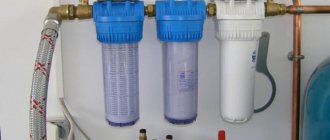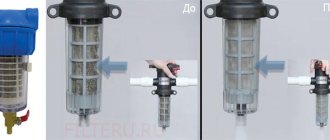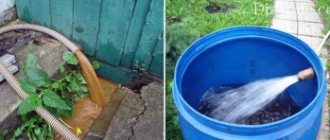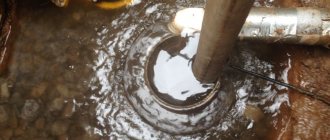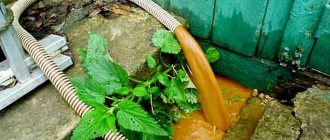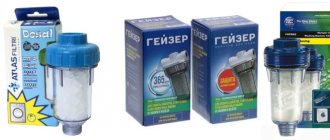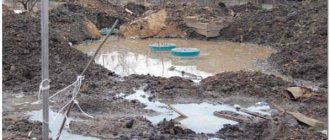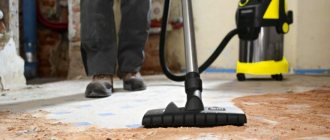Cleaning a well from sand
A well is an alternative to centralized water supply. It solves problems with watering and is used for household needs. But from time to time it is necessary to carry out preventive work to ensure the cleanliness of the well and the serviceability of the system.
Therefore, many site owners are wondering how to clean sand from a well. Many people want to do the work themselves, while saving their money.
Well water quality
A well is the least dangerous source of water, unlike a well, when compared from a sanitary point of view. It is closed and the risk of external contamination being introduced into it is much less. The chemical and microbiological indicator depends directly on the type of well.
- Abyssinian well. Its depth is approximately 8-12 meters. Basically, the water in such a well is highly mineralized and relatively clean. But its microbiological composition leaves much to be desired, because it does not always meet the standards. It may contain various representatives belonging to the nitrogen group of pesticides and other contaminants from the soil. It is purer than artesian water, but sometimes such a source contains a nitrogen subgroup and calcium.
- The artesian well is the deepest. As a rule, it is ideal in its microbiology, often mineralized. The water from this well contains hard salts, such as calcium, hydrogen sulfide, inorganic iron and manganese. The water is not cloudy, but it becomes colored even after the settling process. If such drinking liquid is in a kettle or sanitary equipment, a brown or black coating forms on the walls of the dish.
Regardless of the type of well, before using it, you need to take the water for analysis to a special laboratory and carry out a comprehensive purification of the water from the well - to rid the water of hardness. Note that most wells are not made very deep, up to a maximum of 45 meters, since artesian drilling is a labor-intensive process that requires a special permit.
Quality is determined by the following criteria:
- color;
- cloudiness;
- general iron;
- rigidity;
- chlorides;
- nitrates and nitrites;
- ammonia;
- oxidability;
- alkali and pH;
- presence of microbacteria.
In conclusion
Now you know the main reasons why problems arise with, as well as ways to solve these problems. We wish you always clean water in the right quantities and take care of your sources!
In the video presented in this article you will find additional information on this topic.
Very often people worry that instead of clean and clear water, water comes from a well with turbidity, suspended matter, small particles of sand, and, worst of all, clayey water. Water with clay is the most unpleasant moment, so it is much more difficult to eliminate than sand. To understand how to deal with this problem, you need to understand the reasons that can cause this phenomenon, in other words, find out why water with clay comes from the well.
This problem can be divided into two - water with clay from a recently drilled well, and clayey water from a long-standing and previously well-functioning well.
Types of filters used
Coarse filters for water from a well can be mesh, cassette (also called cartridge) or backfill. Mesh ones are most often placed directly in the well. Such purifiers are a hollow pipeline with a slightly smaller circumference than the wellbore. Holes are drilled or slots are made in the walls of the pipeline (the geometry of the pipe is determined depending on the soil), wire is wound on top, and a mesh is placed over it. The grid cell is selected based on the soil type of the aquifer. Its purpose is not to allow contamination to pass through and at the same time not to become clogged. At this stage, large particles are retained. The bulk of solid contaminants rises to the surface and is eliminated during further cleaning.
Sometimes it is not possible to install a filter in a well. Then the cleaning is moved to the surface. Then you have to use a cassette or fill filter. The cassette contains a removable cartridge - a membrane system and fine wood coal, on which large dirt and sand settle.
In backfill filters, the container is filled with bulk filter material: sand, small shells, special filtrates. They have a simple filter - a barrel of sand, which has a washing function. One point: if there is a lot of iron in the water, it is better to add a special filtrate, because it is a purifier that oxidizes dissolved iron and manganese, causing these elements to settle. If you fill such a filter with small components, it will trap small inclusions. You can install two of these filters at once, but with different backfill.
Causes of siltation
An alarm that should alert the owner of the device is a decrease in water pressure. After this, a brief stagnation usually occurs, accompanied by a characteristic gurgling sound, then muddy water is released and eventually the system stops working.
Siltation occurs for several reasons:
- When drilling a well, the pipe was installed incorrectly. The place where water enters the device is not located in the aquifer or weakly aquiferous layer - a defect during drilling.
- The internal arrangement of the structure also plays a big role. Due to the leakage of the casing pipes, grains of sand enter the source from the side and from above through cracks. Thus, the source is filled with sand.
- There is a small flow of water from the well. Siltation occurs due to the settling of silt, small particles of clay and rust from the pipe at the bottom of the system; they gradually become compacted, which reduces the well's flow rate. If the water consumption is large and frequent use, the risk of siltation decreases.
- If it is not possible to pump water continuously throughout the year, it is recommended to use the well as much as possible in the summer. Perhaps for this purpose it is necessary to turn on the pump for a long time, which will allow the water to circulate, freeing the well from clay and rust. But we should not forget that fine sand particles can only slightly affect the operation of the well; coarse sand particles do not have such an effect on the quality of its operation.
Advice: If during the year it is not possible to increase the frequency of pumping out water, then in the summer it is necessary to pump out more of it.
- To supply water, rotary pumps are used, which draw water; if the depth is not more than 8 meters, this leads to the settling of small particles below this level. To clean such a well, you need to periodically use a vibration pump, and it must be gradually lowered to the very bottom while pumping the device.
- The presence of a filter with a smaller diameter than the main pipe. As a result of this, the pump can drop 20 - 30 centimeters higher than the upper edge of the filter. Over time, the filter fills with sediments that poorly allow water to pass through. Cleaning of this design is done with a vibration pump, which has a smaller diameter and has a lower water intake.
- The use of a vibration pump with an upper water intake.
- Any well must have a filter, which is small holes located in the layer from which water comes. Most often, this is at the bottom of the first pipe. This filter allows solid particles passing through these holes and water to pass through.
- Sometimes specially made filters for wells are installed, which are two pipes of different diameters with holes drilled in them. The wire spiral is wound tightly between the pipes. The disadvantage of such a device is that the internal diameter of the main barrel is larger than the internal diameter of the filter, which does not allow a vibration pump to be lowered to the bottom, and makes it difficult to clean it with such a device having standard dimensions.
Before cleaning the well, you need to determine the causes of breakdowns.
They may be:
- Sand began to come out of the well, which is the first sign of siltation, but it can appear in large quantities in the water for other reasons.
- The flow rate and its potential have decreased. This is the volume of water restored in the well per hour.
- The water became cloudy and an unpleasant odor arose.
- Problems can arise due to irregular operation or errors made during drilling and construction. A change in the direction of the aquifer veins, then the cause will be natural.
- Lack of defense mechanisms. In this case, debris may enter the mouth.
- Reasons may include lack of maintenance or improper pump operation.
There are two main types:
- With filter.
- With a straight barrel.
You can set up the operation of the structure in the following ways:
- Rinse.
- Pump up.
- Blow it out.
Sand removal
Primary cleaning of sand particles, pieces of clay and other large inclusions is carried out with a coarse filter lowered into the well. This is a regular mechanical coarse filter. It consists of a perforated area covered with a fine mesh and a settling tank. As it becomes clogged and the flow of water produced decreases, it needs to be cleaned. Industrial filters are available in different types of designs. Mesh, filter element material is stainless metal mesh. Wire, slotted or combined with gravel packing. The filter can be self-cleaning. For shallow wells, it is optimal to use stainless steel or plastic filter material. A coarse filter can be made at home.
[su_youtube url=”
»]
If there is a lot of suspended matter, you need to install more than one filter, otherwise it will quickly clog. It is better to install a system with cells of various sizes. For example, water from a well enters a filter that retains inclusions up to 100 microns in size, then enters a filter that removes particles of 20 microns. In this way, almost all mechanical impurities can be removed.
Professional assistance from specialists
Which sand removal method should I choose? To answer this question unambiguously, it is necessary to perform a primary diagnosis of the source liquid. To do this, it is necessary to carry out a laboratory analysis of the water, determine its composition, and obtain an official expert opinion.
Production and engineering solves all problems related to high-quality water treatment on a domestic and industrial scale. You can get a free consultation from a specialist by phone: + or write to the operator via online chat. We'll be happy to help!
Water purification from hydrogen sulfide
The main manifestation of the presence of hydrogen sulfide is the pungent odor of rotten eggs, which, when combined with sulfur, is released into a toxic gas and is a dangerous threat to human health. Its source is bacteria that produce sulfides (hydrogen sulfide) during their life processes. Hydrogen sulfide impurities are often found in combination with iron and are eliminated in parallel with it by almost any modern filtration system.
However, in this case, the reverse osmosis method of purifying water from a well from hydrogen sulfide, in which microelements and their large molecules charged with the reagent still pass through the filters, is not applicable. To neutralize such organic compounds, complex purification options are used using electrochemical oxidation, catalytic clarification with ion exchangers, aeration (blowing), biochemical and using deep sorption filters. For adsorption (absorption) and subsequent purification of water from a well from hydrogen sulfide, the method of interaction of organic particles with manganese dioxide is often used, as well as the most current method of using a carbon filter.
Using a powerful compressor is very effective
It is necessary to get rid of sand in the well immediately, as this can also lead to pump failure. There are several methods for cleaning wells from sand. The easiest way is to pump it out using an additional pump. Naturally, any pump will not pull sand in its pure form, so a compressor is also used when pumping. The essence of the method is this: a piece of pipe (about 30 cm) is attached to the inlet pipe of the pump, at the bottom of which a rubber hose from the compressor is connected. The pipe must have holes evenly distributed throughout the entire plane.
Removing sand from a well using the Airlift method.
5-6 holes will be quite enough, but a large number of them can serve you badly, since an excessive amount of water will flow through them, and cleaning will be slower. We turn on the pump and compressor at the same time. The following will happen: air under pressure will lift the sand, mixing it with water. Such a mixture of sand, water and air will easily be lifted to the surface by the pump without creating problems for the pump.
During cleaning, make sure that the pump does not pump air. If there is no longer any water in the well, but sand is still present, then you can either add water or wait until the well fills itself and continue the described cleaning technology. The method is simple but very effective. With the correct selection of pump and compressor, a well can be cleared of sand in approximately 1 hour. Although everything, of course, depends on the depth of the well, the water level in it and the degree of clogging of the well with sand.
Water purification from magnesium, manganese and calcium salts
An increased concentration of salts in water can lead to its hardness with an acceptable limit of 2-3 mg per liter. Salt impurities lead to the appearance of scale on dishes, metal corrosion, a bitter and astringent taste of water and cause urolithiasis and their deposits in the kidneys with regular use, and also increase blood pressure. To reduce hardness, it is recommended to boil water, filter it using reverse osmosis and soften it with resin ions (regenerated with table salt) or alkalis of soda ash.
Cleaning with a highly acidic cation resin or resin requires the use of a separate container and brine tank. The most optimal method is considered to be filters with osmotic membranes, which allow you to completely remove salts from liquids. Also, this method does not require the additional use of reagents to regenerate the filter, since it is self-cleaned by the reverse flow of water.
How to minimize pollution?
Sand and lime may appear in the water due to the initial properties of the aquifer or errors during drilling or use of the well.
You can minimize the likelihood of well contamination with sand grains using a set of measures:
When drilling, you need to monitor the condition of the casing pipe.- The new well should be thoroughly flushed.
- A caisson and a cap should be made on top around the outlet hole.
- In sandy soils, vibrating pumps should not be used for pumping.
- Long pauses in work should not be allowed.
In any case, for long-term safe operation of the well, filters will be required.
Water disinfection
This is the final stage before obtaining a high quality product. For the procedure use the following:
- Blocks with coal or other sorbents.
- Ultraviolet treatment. The device for this looks like a metal case with a quartz case and a UV lamp inside, through which water is driven.
- Chlorination, fluoridation, as well as disinfection with further removal of sediment.
The choice of a water purification system depends on the groundwater biosphere, the results of chemical studies of the liquid, and the presence of anaerobic microorganisms in it. Typically, home stations use the first two methods.
Cheap septic tanks made of concrete rings
A simple, effective and environmentally friendly solution for owners of areas with deep groundwater and sand is the installation of several concrete wells isolated from precipitation.
How it works? Two or three concrete wells are buried vertically in the ground and connected to each other by overflows. The first well (the bottom of which is hermetically sealed) receives wastewater from the house, including solid waste. Liquid waste is poured either into a second well (at the bottom of which small fractions settle) or directly into a waste disposal well. Its bottom is covered with gravel, expanded clay, crushed stone - water seeps through them and goes into the soil.
In such a “concrete septic tank” anaerobic bacteria live and multiply, which do not need oxygen to function. Concrete wells can be of any size (KS 10-9 is often used) with an internal diameter of 1 m, an outer diameter of 1.6 m and a height of 0.9 m. From several concrete wells you can “assemble” one buried one.
Sectional diagram of concrete septic tanks
Among the disadvantages of the “septic” method are the following:
- water cannot be reused;
- it is not yet possible to achieve complete tightness of a system of several wells;
- the filter bottom of wells quickly becomes clogged and stops releasing water into the soil;
- To install such a system you will need serious construction equipment. A large amount of work will have to be done, but this will not save you from calling a sewer truck, as in the case of a storage unit.
Iron and lime removal
The most common problem with drinking liquid recovered from wells is the increased content of iron and lime. Speaking in terms of sanitary standards, the permissible level of iron in water is 0.3 mg/l. If the concentration is higher than this indicator, a specific taste occurs. And if the iron content is more than 1 mg/l, the color changes - after a short period of settling, a rusty tint appears. Therefore, it is necessary to purify water from iron. Purifying water from a well from lime is possible in different ways.
Methods for purifying water from a well from iron:
- Settling is the simplest method. Cleaning is carried out using a reservoir into which the daily volume of liquid consumed is placed. If the water is turned off, you can use this reserve.
- Aeration is a system for filtering water from iron, in which the liquid medium comes into contact with oxygen. In the process, dissolved iron particles are oxidized to an insoluble consistency, after which they settle down.
- Ozonation installations. Water is purified through active oxidizing agents. Can be filtered with chlorine and ozone. Chlorination is harmful and is therefore rarely used. Ozonation is the safest method.
- Ion exchange method. The use of this method involves the use of special filters. They need to be mounted in a structure under the sink. The filter is made of artificial resin containing free ions. The contact of water with the molecules causes the water and iron molecules to change places.
- Reverse osmosis. This method involves the use of purifiers that trap particles at the molecular level. Thanks to this method, even dissolved components are removed.
Effective cleaning methods
Bailer for cleaning
a well The simplest option for dealing with a silted bottom is to use a bailer: a piece of steel pipe with teeth on one side and special flaps there. The principle of its operation is that when it free falls from a height of 0.6-0.8 meters, it crashes into a layer of sand deposits with its weight. At this moment, the bailer flaps open and sludge enters the pipe cavity. When it rises, the blades close, preventing dirt from flowing back into the casing space.
As soon as the volumes of lifted sludge are very low, a stream of water under high pressure should be applied to the bottom of the shaft. This will help wash away any remaining dirt in the filter area. The dirty liquid is pumped out with a powerful pump until a clean water resource appears.
Using a bailer you can clean wells up to 15 meters deep. If it is longer, the master will no longer be able to cope with the problem.
Mechanical flushing
Cleaning a well using two pumps
Here you need to use two pumps - one powerful for supplying water under pressure to the siltation zone, the second drainage for pumping dirty liquid upward. Both units must operate simultaneously.
The supply hose is equipped with a special weight so that it does not rise to the top under the pressure of incoming water. It is lowered approximately 20-25 cm from the silt layer. The intake hose is placed a little higher (30-40 cm from the bottom). Turn on both pumps and start working. The incoming liquid will break up the sludge deposits, and the drainage pump will pump them upward.
It is advisable to prepare a special barrel or other reservoir for dirty water. A bucket without a bottom, covered with fine mesh underneath, is attached to its upper edge. Water will pass through such a homemade coarse filter and be cleared of grains of sand.
Periodically, the drainage pump must be turned off and washed to remove accumulated dirt.
Use of special equipment
If the well is driving sand, special equipment can come to the rescue - a fire truck. Renting equipment will cost a pretty penny. But the work can be done in half an hour.
The principle of operation is that the operator will supply large volumes of water into the well through a fire hose, and with its help will pump out the liquid contaminated with silt.
How to install a well water purification system
A water purification system from a well is installed based on its productivity. If it is a mechanical filter, you can make it yourself or buy a ready-made one. option In any case, all well water purification filters require the assembly of a container. Additional coarse filtering elements are mounted on the water supply pipeline. Afterwards, deep cleaning systems are installed on these elements, during installation of which you must follow the instructions.
As a rule, it is necessary to allocate a certain space in the utility room of the house for productive stations. If we are talking about small-volume keys, it is enough to buy a device that is installed under the sink, from which you need to remove a separate faucet.
To install water treatment elements you will need the following tools and materials:
- gas and adjustable wrenches;
- plastic pipes 30-40 mm;
- fittings for pipes;
- tools for cutting and welding pipelines, as well as making threads;
- waterproofing material for pipe connections.
DIY production and photo examples of design
Unlike innovative cleaning devices, a traditional depth filter can be made with your own hands. For this you will need ordinary stainless or polymer pipes.
It should be taken into account that for all pipes for installation deep in the well, the lower part remains intact and serves as a sump.
Perforated version
There are several types of filters with holes of different shapes that you can cut yourself .
One of the popular filters has slots:
- To cut the slots, the pipe is firmly fixed.
- Make the markings in a checkerboard pattern, taking into account the required distance.
- Select a tool with a suitable blade width.
- Cut slits at a distance of 2 to 7 cm.
- A mesh can be attached to the top along the entire length of the pipe.
Photos of design examples:
Round holes are made in the same way. The material used for the mesh is stainless steel with galloon weave and polymers . When choosing meshes, you need to pay attention to the markings. The larger the numbers indicated, the smaller the cell sizes. Accordingly, such a mesh will be able to retain small grains.
Expert advice on purchasing filters for well water purification
Before purchasing a filter for purifying water from a well, consider the volume of consumption, the capabilities of the sewer system, and the dimensions. The equipment complex may consist of one or two cylinders and a tank with a reagent. Together with a coarse and household filter, this will be enough for a private country house. You can buy a cheap purification complex. This is sometimes better than replacing equipment that has become faulty due to accumulation of deposits and rust. The choice of a filter for purifying water from a well is yours!
Preventive measures
To prevent the well from producing sand over time and causing trouble to its owner, it is important to take a number of preventive measures.
- Completely pump (flush) the source after drilling it. It is important to do this until the water comes out completely clean.
- Correctly calculate the fraction of filter mesh cells based on the size of sand grains. This can be done by experienced professionals.
- Monitor the strength and reliability of all connections of the casing pipe during its installation.
- Use a pump whose technical characteristics correspond to the performance of the source. A unit that is too powerful will either deplete the well or drive sand.
- Operate the hydraulic structure regularly (even in winter). Seasonal downtime leads to silting of the filter. If it is impossible to avoid seasonal operation of the well, it is advisable to come to the site once a month and pump out at least 100-150 liters of water.
It is always easier to prevent a problem than to solve it later.
How to avoid well clogging? Important points
So, we found out that sooner or later problems arise for all well owners. Of course, if the aquifer dries up, then it will be necessary to deepen the mine or drill a new well, which can hardly be considered easy and cheap procedures.
For most private homes, a well is the main and often the only source of uninterrupted water supply
Reasons for well siltation
It’s a completely different matter if the well is clogged - this can even be avoided if you operate it according to all the rules. How to extend the service life of the water supply source on the site?
Table. Well operation rules.
| Rule | Short description |
| Follow the selected drilling technology | Carefully ensure that the casing pipe is sealed and the filter is intact. |
| Make sure the well is not idle | Ideally, several tens/hundreds of liters need to be pumped out every day, and this is not a problem if people live in the house permanently. Otherwise, try to pump out at least a hundred liters every two months. |
| Well flushing | Once you have finished drilling, immediately flush the source until clear water appears. |
| It is better to abandon the vibration pump | The fact is that such a pump, vibrating, will contribute to siltation of the soil or the entry of sand into the well (to a greater or lesser extent). It is better to use a centrifugal pump for this purpose. |
| Protect the well from contamination and surface water ingress | Install a head or caisson for this. As an option (but only temporary), seal the top of the casing. |
| Choose the right submersible pump | Do this before you start operating the well, taking into account the water flow, and install the device at the desired height. |
Abyssinian water well
Note! If you follow all these recommendations, you still will not be able to prevent the well from clogging. But you will be able to delay the problem and achieve maximum effective use of the resource.
Proper construction of a well is the key to its longevity. It is necessary to install a special head on the casing pipe, which seals it and serves for reliable installation of equipment
Using a simple metal pipe
The most primitive way to clean a well is to use a regular metal pipe. How to get rid of sand this way? It’s very simple: we block 1 end of the pipe, and lower the 2nd end to the bottom of the well, pressing it tightly to the surface. Now air access to the pipe can be opened. You have to lower the pipe as low as possible so that the sand gets into it as high as possible. Again we block the upper end of the pipe and raise it to the surface. Excessive pressure from outside will not allow the sand to leave the pipe, and you will bring it to the surface. We repeat the procedure until the well is completely cleaned. Note that for this method it is necessary to make a reliable valve, since air should not enter the pipe. After all, in this case atmospheric pressure will work.
Using a screw is the most difficult cleaning method
Maximum permissible concentrations of various substances in water.
Let us remember the great physicist Archimedes. He also created a screw, which even in ancient times was used to raise water or sand to the surface. Currently, such a screw is used very often and can be successfully used to clean a well. It is enough just to have a pipe with a screw inside. Such a device must reach precisely the dense layer inside the well. The rotation of the screw will raise the sand to any height, you just need to provide it with torque. If you add an electric motor to the device, the work will be done without your effort. Note that it is quite problematic to find a suitable screw, so this method is very difficult to use.
